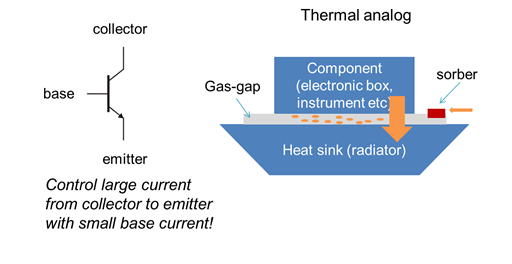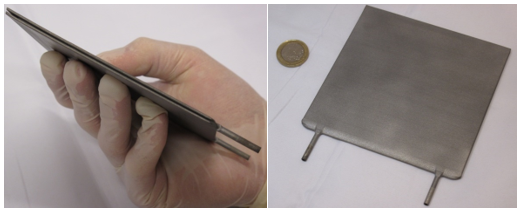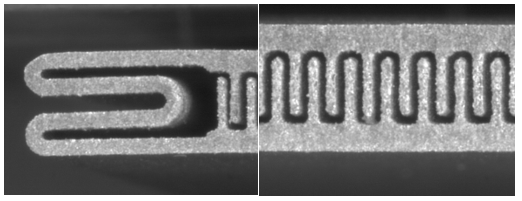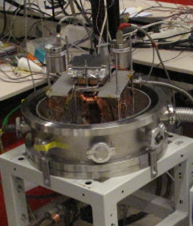We are a very passionate team of technologists and we believe that scientific advancements can be made with a good hands on instruments. Here is a list of novel technologies that materialized from our lab. Some of these methods are adopted in industrial products.
- Flat panel gas gap heat switch
Heat switches are devices that can change from a thermally conducting (on-) state to an insulating (off-) state whenever the need arises. They enable adaptive thermal management strategies in which cooling rates are altered either spatially or temporally, leading to a substantial reduction in the energy and mass budget of a large range of systems. State-of-the-art heat switches are only rarely employed in thermal system architectures, since they are rather bulky and have a limited thermal performance (expressed as the heat transfer ratio between the on- and off-state heat conductance). Using selective laser melting additive manufacturing technology, also known as 3D printing, we conceived and developed a compact flat-panel gas-gap heat switch that offers superior thermal performance, is simpler and more economic to produce and assemble, contains no moving parts, and is more reliable because it lacks welded joints. The manufactured rectangular panel heat switch has frontal device dimensions of 10 cm by 10 cm, thickness of 3.2 mm and weighs just 121 g. An off heat conductance of 0.2 W/K and on-off heat conductance ratio of 38 is observed at 295 K. The measured on-conductance with a heat sink temperature of 115 K and the hot plate at 120 K is 0.134 W/K, the on-conductance with helium and hydrogen gases at the same temperatures is 4.80 W/K and 4.71 W/K, respectively. This results in an on/off conductance ratio of 37 and 35 for helium and hydrogen gas, respectively.

Working principle of the gas-gap heat switch

More information:
https://doi.org/10.1016/j.cryogenics.2016.07.006
https://doi.org/10.1063/1.4936356Heat transfer model of interleaving fins:
An accurate physics based prediction of the heat transfer in these structures, which takes into account the interplay of the geometry, temperature dependent physical properties of the materials is lacking. In this study, we identify that the finite conductivity of the fins can result in a strong reduction in heat transfer rate and we develop and validate a one dimensional model to describe this accurately. We identified a single non-dimensional number predicting this effect, which is a combination of the geometry and the ratio of thermal conductivities of the fins and the medium between them. This result will provide various insights and a tool to properly design engineering solutions to heat transfer problems using interleaving fins.More information: https://doi.org/10.1103/PhysRevApplied.12.064048
Sponsor: European Space Agency - Sub cooling liquid nitrogen
Cryogenic liquids are often produced and transported at a saturation state. In quenching process, sub-cooling a liquid has shown to increase the cooling rate. We are developing novel method to sub-cool a cryogenic liquid.
Bubble cooling
Injecting an insoluble gas into a liquid results in sub-cooling of the liquid, due to forced evaporation into the bubble. Previous studies have assumed the rate of evaporation of the liquid into the bubbles to be independent of the degree of sub-cooling, but in this study we quantify the bubble growth directly by high-speed imaging, and disprove this hypothesis. The bubble expansion ratio is a strong function of the liquid’s temperature.
More information: https://doi.org/10.1103/PhysRevApplied.11.054038
Open bath sub-cooling
We invented a novel approach to sub-cool a liquid cryogen bath. We will soon reveal this method.
- Insulation measurement apparatus (room to cryogenic temperature)
A single-sided guarded-plate apparatus has been developed to measure thermal conductivity of insulation panels of sub-meter size at sub-ambient temperatures ranging from 80 to 300 K. This apparatus allows thermal conductivity measurements to be performed at large temperature differences simulating the actual operating conditions in an application and can accommodate panels of various thickness. The cold plate in the apparatus is cooled by a GM cryocooler.

More information:
https://doi.org/10.1016/j.ijrefrig.2016.11.022
https://doi.org/10.1016/j.cryogenics.2016.07.006Sponsor: UT institute funding
- High frequency Stirling cryocooler
We are excited to announce that in collaboration with Thales Cryogenics and Absolut Systems we won a European Space Agency tender to design and develop a high frequency pulse tube cryocooler for future space missions. More details will follow.
